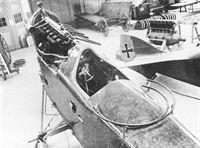
Описание
Страна: Австро-Венгрия
Год: 1917
P.Grosz, G.Haddow, P.Shiemer Austro-Hungarian Army Aircraft of World War One (Flying Machines)
WKF 80.01 to 80.03
References which would correctly identify the WKF 80.01-80.03 prototypes have not been found in LFT records. It has been suggested that these prototype designations were assigned to the first aircraft of the first three production series built by WKF; namely, the Lloyd C.III(WKF) series 43.5, the Lloyd C.IV(WKF) series 44.5, and the Knoller C.II(WKF) series 81, but confirmation is lacking.
WKF 80.04
The 80.04 two-seat reconnaissance biplane, the first prototype to originate from the WKF design department, was conceived by Ingenieur Alfred Gassner. He chose a fuselage configuration on the basis of wind tunnel tests which had shown a hexagon cross-section to have superior directional stability than a square or round section and less drag than a square one. The robust, plywood-covered fuselage featured a deep "keel" to reduce the aerodynamic interference at the wing-fuselage juncture and facilitate mounting a one-piece lower wing. The generous fuselage depth allowed lowering the engine axis to provide good forward visibility and the installation of a 90cm camera entirely within its profile. To minimize drag, the patented Lloyd veneer-covered wing was adapted by Gassner in the form of a semi-cantilever cellule braced solely by a pair of crossed V-struts attached to the fuselage.
Construction of the prototype, a private-venture undertaking, began in July and was completed in September 1917, when the prototype arrived at Aspern for evaluation. Power was supplied by a 200 hp Daimler engine. The initial flight tests failed to demonstrate "any noteworthy performance." There is little doubt that redundant weight, often the case with new aircraft, was the reason. In the course of static load testing, directed by Schieferl on 27 October 1917, the 80.04 airframe did not fail until a load factor of 8 was reached, well above the required factor of 5. Even then only a single center-section strut fitting had collapsed. This fully confirmed the strength of the WKF design and the veneer-covered wing cellule developed by Lloyd. Flight performance testing continued in November 1917, after which date the 80.04 prototype disappears from Flars records.
WKF 80.04 Specifications
Engine: 200 hp Daimler
Wing: Span Upper 8.96 m (29.40 ft)
Span Lower 7.82 m (25.66 ft)
Chord Upper 1.90 m (6.23 ft)
Chord Lower 1.60 m (5.25 ft)
Stagger 0.45 m |1.48 ft)
General: Length 7.30 m (23.95 ft)
Height 2.70 m (8.86 ft)
Track 1.80 m (5.91 ft)
Empty Weight 630 kg (1389 lb)
Loaded Weight 1030 kg (2271 lb)
Описание:
- P.Grosz, G.Haddow, P.Shiemer Austro-Hungarian Army Aircraft of World War One (Flying Machines)
- E.Hauke, W.Schroeder, B.Totschinger Die Flugzeuge der k.u.k. Luftfahrtruppe und Seeflieger 1914-1918
Фотографии
-
P.Grosz, G.Haddow, P.Shiemer - Austro-Hungarian Army Aircraft of World War One /Flying Machines/
Photographed at the time of its debut in September 1917, the WKF 80.04 prototype shows off its clean, purposeful lines. As was customary, the optimum location of the observer’s seat and gun ring was determined in the course of flight testing.
-
P.Grosz, G.Haddow, P.Shiemer - Austro-Hungarian Army Aircraft of World War One /Flying Machines/
WKF 80.04. The highly-polished wing cellule devoid of wire bracing, the prominent spinner, and well-faired nose radiator demonstrate designer Gassner’s concern with streamlining.
-
E.Hauke, W.Schroeder, B.Totschinger - Die Flugzeuge der k.u.k. Luftfahrtruppe und Seeflieger 1914-1918
WKF, zweisitziges C-Mehrzweckflugzeug. Flugzeugnummer 80.04. Fischamend, gekreuzte Streben, 1917
WKF, двухместный многоцелевой самолет C. номер 80.04. Фишаменд, перекрещенные стойки, 1917 г. -
P.Grosz, G.Haddow, P.Shiemer - Austro-Hungarian Army Aircraft of World War One /Flying Machines/
In the final version of the WKF 80.04, the fin and rudder areas were increased. A four-bladed propeller provided increased thrust to obtain maximum performance.
WKF-C-Flugzeug, 80.04. Umbau, mit anderem Motor bzw. Motorverkleidung
Самолет WKF-C, 80.04. Переделка, с другим двигателем или капотом двигателя -
P.Grosz, G.Haddow, P.Shiemer - Austro-Hungarian Army Aircraft of World War One /Flying Machines/
An Aviatik C.I(WKF) converted to a photo-reconnaissance fighter at the WKF factory. The rear cockpit has been faired over, but the gun ring has been retained for re-conversion to a two seater if required. According to some reports, the gun ring fooled Allied fighter pilots into believing the aircraft was a two seater. In the background is the beautifully-faired tail of the WKF 80.04 prototype.
Другие самолёты на фотографии: Aviatik (Berg) C.I - Австро-Венгрия - 1917






